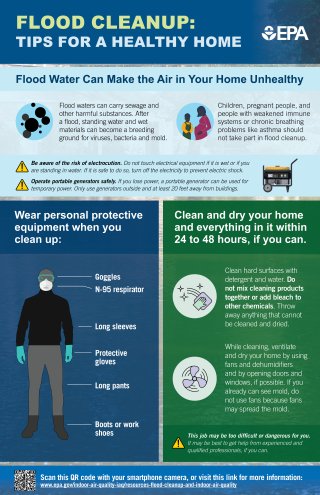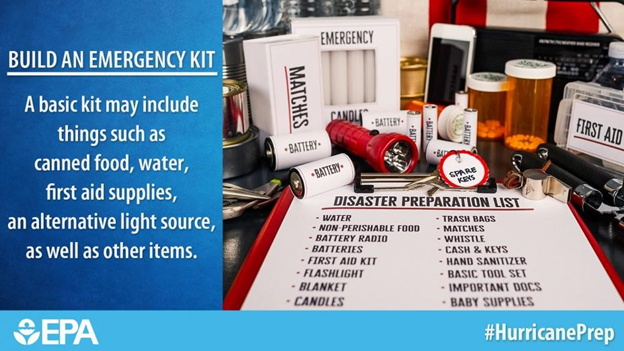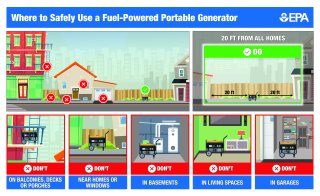Emergencies and Indoor Air Quality (IAQ)

Available in these languages:
Preparation and response to weather-related and man-made emergencies is particularly important when it comes to indoor environments, since humans spend most of their time indoors, and rely on indoor spaces for shelter. Educating yourself about how to prepare for and respond to weather-related and man-made emergencies that affect indoor environments can help protect you and your family by preserving healthy indoor air quality.
On this page:
- Emergencies, IAQ and Health
- How Do Emergencies Affect the Indoor Environment?
- General Tips and Safety Practices
- Additional Resources
On other pages:
- Wildfires and Indoor Air Quality (IAQ)
- Create a Clean Room to Protect Indoor Air Quality During a Wildfire
- Wildfires and Indoor Air Quality in Schools and Commercial Buildings
- Resources for Flood Cleanup to Protect Indoor Air Quality
- Power Outages and IAQ
- Adapting Buildings for Indoor Air Quality in a Changing Climate
- Indoor Air Quality and Climate Change
- Natural Disasters
- Homeland Security and the Indoor Environment
- Radiation Emergencies and Preparedness
Emergencies, IAQ and Health
Our homes and buildings, where we spend most of our time, provide protection from the conditions outdoors. Several factors, including the design, construction, operation, and maintenance of buildings, as well as people’s activities indoors, can impact the air we breathe indoors and ultimately our health. Emergencies can affect these conditions by worsening existing indoor air quality issues and introducing new ones. Additionally, certain emergencies, such as extreme heat events, hurricanes and flooding, wildfires, and dust storms are expected to increase in frequency and severity as a result of climate change.
Some people may be more susceptible to changes in indoor air quality and other impacts related to emergencies, including:
- Children,
- Pregnant women,
- Older adults, and
- Individuals with pre-existing medical conditions
Health effects from indoor air pollutants may be experienced soon after exposure or, possibly, years later. We can reduce the impact to building occupants and especially those most vulnerable by maintaining a safe and healthy indoor environment before, during, and after emergencies. Learn more about:
How Do Emergencies Affect the Indoor Environment?
Wildfires, Volcanic Eruptions, and Dust Storms
Smoke and/or other particle pollution generated outdoors during events such as wildfires, volcanic eruptions, and dust storms can infiltrate into indoor environments and contribute to levels of indoor particulate matter (PM). Wildfires, which have increased in size and frequency in recent years, expose populations to smoke and byproducts of combustion such as ash. In addition, when wildfires move through communities, chemicals can be released into the air from burning structures, furnishings, and any other materials in the fire’s path.
Volcanoes can erupt without warning and may release ash and harmful gases that can make it hard to breathe. Strong surface winds and thunderstorm cells can lead to dust storms, which can occur anywhere in the United States, but most commonly occur in the Southwest.
Actions You Can Take
- Check your state or local air quality agency’s website or AirNow.gov for air quality forecasts and current air quality conditions. During a wildfire, see these tips for Using Air Now During Wildfires.
- Keep your windows and doors closed during these high outdoor pollution events. If you cannot stay cool at home, seek shelter elsewhere.
- Consider using a portable air cleaner in the room(s) where you spend the most time.
- Consider using a high-efficiency filter in your heating, ventilation, and air conditioning (HVAC) system. Use a filter rated Minimum Efficiency Reporting Value (MERV) 13 or better, or as efficient a filter as your system can accommodate.
- Adjust your HVAC system or air conditioner to keep smoke and other fine particles out during these events by changing the settings to recirculate the air.
- Consider purchasing N95 respirator masks to protect your lungs from smoke and other fine particles during these events.
- Air out your home by opening windows or opening the fresh air intake on your HVAC system when the air quality improves, even temporarily.
Learn more about these and other steps you can take before, during, and after a wildfire event to protect your family, by visiting Wildfires and Indoor Air Quality (IAQ).
Learn More About Wildfires, Volcanic Eruptions, and Dust Storms
- Learn more about Indoor Particulate Matter
- Particulate Matter Pollution
- Wildfires Resources One-Pager (PDF).
- How Smoke from Fires Can Affect Your Health
- Create a Clean Room to Protect Indoor Air Quality During a Wildfire
- Wildfires and Indoor Air Quality in Schools and Commercial Buildings
- Smoke-Ready Toolbox for Wildfires
- Wildfires
- Wildfire Smoke: A Guide for Public Health Officials and Factsheets
- CDC - Volcanoes
- CDC - Air Quality and Emergencies
- CDC - Ready Wrigley Prepares for Wildfires and Smoke
- Victoria, Australia - Airborne Dust Exit
- State of New Mexico Dept. of Health - Dust Storms and Health (PDF) Exit
- Maricopa County, Department of Emergency Management – Are you Ready? Dust Storms (PDF) Exit
- The International Volcanic Health Hazard Network (pamphlets) Exit
Power Outages
Power outages that last longer than a few hours can have negative impacts on indoor environments. Carbon monoxide (CO) resulting from the improper use of portable generators is one of the most significant threats following a power outage. At elevated levels, CO can quickly cause significant harm and even death. Additionally, the lack of climate control and reduced ventilation and filtration of indoor air can also contribute to loss of thermal control, increased levels of indoor pollutants, and adverse indoor conditions and health impacts.
Actions You Can Take
- Do not use portable generators (powered by fuel) indoors. Safely provide power for lighting, cooking and heating. Use portable generators outside and at least 20 feet away from buildings. Ensure combustion devices have adequate ventilation.
- Install CO alarms to prevent CO poisoning. Ensure they are working properly, and check or replace the battery when you change the time on your clocks each spring and fall.
- Consider using portable generators powered by batteries or solar power stations to power small appliances, lights and fans.
- Use ventilation and shading to help control indoor temperatures.
- Learn more about the steps you can take to maintain safe indoor air quality during power outages.
Learn More about Power Outages
- Power Outages and Indoor Air Quality One Pager (PDF)
- Carbon Monoxide's Impact on Indoor Air Quality
- Flood Cleanup and the Air in Your Home booklet (with illustrations of how and where to use portable generators)
- Homeowner’s and Renter’s Guide to Mold Cleanup after Disasters (with portable generator safety tips from multiple federal agencies)
- CDC - Carbon Monoxide Poisoning Frequently Asked Questions
- CPSC - Generators & Engine-Driven Tools
- Ready.gov - Power Outages
Hurricanes and Flooding
During hurricanes and stormy weather, there is an increased risk of flooding and dampness indoors. In recent years, hurricanes have increased in both frequency and severity. Floodwaters may contain many hazards, including biological and chemical contaminants. Following a flood or hurricane event, standing water and wet materials can become a breeding ground for microorganisms, such as viruses, bacteria and mold. Exposure to these contaminants can cause disease, trigger allergic reactions and continue to damage materials long after the flood. Additionally, stormy weather and flooding can drive pests indoors looking for shelter and food. Pest infestations are often combated with pesticides that may lead to harmful exposures if they are not properly applied.

Actions You Can Take
- Safe and thorough cleanup following extreme weather and other emergency events is essential to ensuring the safety of building occupants.
- Follow EPA guidance for cleaning up after a flood to reduce the potential for mold growth, and to avoid harmful exposure to mold spores and certain cleaning products used during flood cleanup. Some cleanup activities include:
- If you have evacuated, you and your family should wait to re-enter your home until professionals tell you it is safe, with no structural, electrical or other hazards.
- Before you start cleanup activities, contact your insurance company and take pictures of the home and your belongings.
- Wear personal protective equipment when you clean up. Wear an N-95 respirator at a minimum, goggles, and protective gloves.
- Clean with water and a detergent. Remove all mold you can see. Dry right away.
- Dry your home and everything in it as quickly as you can – within 24 to 48 hours if you can.
- Ensure the mold cleanup is complete before reoccupying your home.
Learn More about Hurricanes and Flooding
- Learn more about Flood Cleanup to Protect Indoor Air Quality and Your Health.
- Find Resources for Flood Cleanup and Indoor Air Quality
- Flood Cleanup and Indoor Air Quality: Resource Summary (PDF)
- Learn more about mold.
- Learn more about pesticides.
- CDC - Ready Wrigley Prepares for Hurricanes
Extreme Heat
Hotter summer temperatures have become more common across the United States in recent decades due to climate change. Extreme heat events (heat waves) are expected to become longer, more frequent, and more intense in the future. Indoor temperatures can also rise quickly during power outages, when HVAC systems and other methods of cooling are no longer operating. When people are exposed to extreme heat, they can suffer from potentially deadly illnesses, such as heat exhaustion and heat stroke. Hot temperatures can also contribute to deaths from heart attacks, strokes, and other forms of cardiovascular disease. Straight forward simple strategies can be used to help prevent heat-related deaths and illness.
Actions You Can Take
- Use ventilation and shading strategies to help control indoor temperatures.
- Use air conditioners or spend time in air-conditioned locations such as designated cooling zones, malls and libraries.
- Use portable electric fans to exhaust hot air from rooms or draw in cooler air. Do not direct the flow of portable electric fans toward yourself when room temperature is hotter than 90°F.
- Stay hydrated – regularly drink water or other nonalcoholic fluids.
- Check on older, sick, or frail people who may need help responding to the heat.
- Know the symptoms of excessive heat exposure (CDC) and the appropriate responses.
Learn More About Extreme Heat
- Learn more about Extreme Heat
- Excessive Heat Events Guidebook
- Tips to Help You and Your Home Withstand Weather Extremes and Maintain Indoor Air Quality
- Power Outages and IAQ
- CDC - Extreme Heat
- CDC - Ready Wrigley Prepares for Extreme Heat
Snow and Ice
Snow and ice can lead to dangerous or adverse indoor conditions. They can result in ice dams and other moisture problems from melting snow and ice, power failures, loss of building heat and ventilation and loss of communication service. Snow and ice can also block furnace vents, causing a buildup of CO and other harmful air pollutants indoors. Know how to keep yourself and your loved ones safe while indoors during a snow and ice storm.
Actions You Can Take
- Prevent CO poisoning, by installing CO alarms and checking them periodically to ensure they are working properly.
- Use generators and other appliances safely. Learn about how to Safely Provide Power for Lighting, Cooking and Heating during a power outage.
- Make sure snowdrifts are not covering the outside (sidewall) exhaust vents, for example from your furnace, water heater, dryer, or other appliances.
- If you use a fireplace or a wood stove, see Learn Before You Burn Wood - What You Can Do for more information about Burn Wise for safer fires.
- Try to conserve heat and control indoor temperatures.
- Make sure babies and older adults stay warm. Check on elderly friends and neighbors often to make sure their homes are heated properly.
- Know the signs and symptoms of hypothermia (CDC) (abnormally low body temperature) and the appropriate responses.
- Limit the potential for mold.
- If you can, insulate water lines that run along exterior walls so your pipes will be less likely to freeze. Check out this Department of Energy video to learn how.
- Shut off and drain outdoor spigots before freezing temperatures arrive.
- During extreme cold, prevent pipes from bursting. Leave indoor water taps on exterior walls slightly open so they drip continuously. Don’t set the temperature too low and open cabinet doors to allow warm air to reach pipes. Be sure to move any harmful cleaners and household chemicals out of the reach of children and pets.
- If you have burst pipes and wet walls and carpet, learn how to prevent mold in your home during cleanup.
Learn More About Snow and Ice
- Learn more about Snow and Ice
- Carbon Monoxide's Impact on Indoor Air Quality
- Tips to Help You and Your Home Withstand Weather Extremes and Maintain Indoor Air Quality
- CDC - Winter Weather
- Ready.gov - Winter Weather
- CDC - Ready Wrigley Prepares for Winter Weather
Earthquakes
Earthquakes occur without warning and can cause severe damage to buildings and disrupt systems designed to protect indoor occupants. Damaged buildings, damaged power lines, and leaking gas and water lines are just a few of the hazards you might face after an earthquake. When earthquakes damage buildings, occupants’ exposure to contaminants found in certain building materials, such as lead and asbestos, can increase. Damaged power lines may result in power outages. Broken gas lines greatly increase the risk of fire, explosion, or poor air quality.
Actions You Can Take
- Learn about the steps you can take to prepare for, respond to, and recover from an earthquake.
- If you suspect a gas leak or pipe damage, evacuate the area and call local authorities or 911 from a safe location.
- Carefully clean up spilled medicines, household chemicals, and gasoline or other flammable liquids immediately, making sure to wear appropriate personal protective equipment and ensuring that the space you are working in has adequate ventilation.
- If you see structural damage in your home, like cracks in the foundation or missing support beams, you may need to relocate to a shelter or another safe location until you can have the space evaluated by a professional.
- Loss of power is common, keep yourself and your loved ones safe and learn more about safe indoor air quality during power outages.
- Listen to reports from local officials for advice on water precautions in your home. Learn more on how to keep food and water safe after a disaster (CDC).
- Levels of radon in a building may increase as a result of damaged infrastructure following an earthquake. Following cleanup and repair of your home, consider testing your home for radon.
Learn More About Earthquakes
Chemical, Biological, and Radiological and Nuclear (CBRN) Threats
Chemical, biological, or radiological or nuclear (CBRN) threats may occur naturally, accidentally, or intentionally. Regardless of the source, people are in potential danger when exposed to these threats, some of which may be airborne. Since people spend most of their time indoors and rely on indoor spaces for shelter, specific considerations are important during CBRN emergencies to reduce the impact to building occupants. This includes considerations for the layout and design of a building, the building’s occupancy, as well as heating, ventilation, and air conditioning (HVAC) system design, operation, and maintenance, which can all impact potential spread of airborne CBRN threats.
A chemical emergency occurs when a hazardous or poisonous chemical is released into the environment or indoors that has the potential to harm people’s health. Chemicals can be released unintentionally, such as the release of toxic gas from a volcanic eruption or an industrial accident, or on purpose, such as in a terrorist attack.
Biological threats include infectious diseases, caused by bacteria and viruses, that have the potential to spread and cause an outbreak of illness in humans. Many known and emerging bacteria and viruses have the potential to cause infectious diseases, but each have different characteristics, such as how they are spread and how severe of an illness they cause. Many infectious diseases can be spread by germs carried in air, water, food, or soil, or by biting insects or animals. Biological threats may spread naturally or intentionally in a bioterrorism attack (CDC).
- The COVID-19 pandemic, caused by the novel coronavirus SARS-CoV-2, is an example of an incident caused by a naturally occurring biological threat.
- The 2001 anthrax (CDC) incident or attack is an example of an intentionally released biological agent or threat.
In cases when bacteria or viruses can be spread by the airborne route or become airborne for distribution, it is important that additional strategies be implemented to reduce potential spread of illness indoors.
Lastly, in a radiation emergency (CDC), such as a nuclear power plant accident, transportation accident, dirty bomb explosion (a mixture of explosives and radioactive powder or pellets), or nuclear blast, a large amount of radiation could be released and has the potential to harm your health and the health of your family. Radiation experts across the government agree that, during a radiation emergency, people in the affected area should turn off HVAC systems if they are not at risk of heat-related injury. This reduces the already small risk of radioactive material entering your shelter.
Actions You Can Take
- Visit EPA’s Indoor Air and Coronavirus (COVID-19) page to learn about some of the straightforward approaches that can be used to reduce the spread of COVID-19 indoors.
- Visit EPA’s Homeland Security and the Indoor Environment page to learn about recommendations that building owners and managers can implement now to protect indoor environments from release of CBRN agents, including guidance for filtration and air-cleaning systems, HVAC systems, and considerations for establishing building emergency response plans.
Learn More About Airborne CBRN Threats
- Indoor Air and Coronavirus (COVID-19)
- Radiation Emergencies and Preparedness
- Radiological Emergency Response
- Centers for Disease Control and Prevention (CDC):
- Institute of Medicine, National Academies of Science Engineering and Medicine:
General Tips and Safety Practices

Prepare for Emergencies
- Have a battery-powered radio to keep you informed and prepared for approaching severe weather conditions in your local area and have access to a telephone in case of emergency.
- If possible, identify emergency shelters in advance. If your home is without electric power for a sustained period of time, you may want to make arrangements to stay in an emergency shelter or other alternate location if practical.
- Consider preparing a family emergency supply kit that includes some essentials that you may need when a disaster happens.
Emergency Communication
- Listen to state and local public health agencies’ public service announcements (PSAs) or news releases advising the public on how to protect your health and prepare your home in the event of severe weather conditions or other type of emergency.
Re-Entering Damaged Homes and Buildings
- Learn when it is safe to re-enter a damaged home and what general precautions can be taken to protect you and your family from hazards in any disaster circumstance.
Cleanup and Dealing with Building Materials, Debris, and Rebuilding
- Building materials damaged by the event or disturbed by a post-event renovation may contain harmful contaminants, such as lead and asbestos.
- Home renovation should be performed in a manner that keeps the homeowner and all occupants safe.
- Consult with a professional on rebuilding and incorporate guidance on remodeling and IAQ.
- Homeowners may want to consider rebuilding with resilience to future disasters in mind.
- FEMA - Homeowner’s Guide to Retrofitting (PDF)
- FEMA - Mitigation for Homeowners Fact Sheet
- Learn more about dealing with debris and damaged buildings.
General Strategies for Improving IAQ
- There are a number of strategies homeowners and building managers can take to improve IAQ during or following an emergency event including source control, ventilation, and supplemental filtration and air cleaning.
Additional Resources
- Natural Disasters
- Ready.gov
- CDC- Information on Specific Types of Emergencies
- American Red CrossExit
- OSHA - Emergency Preparedness and Response
- CDC - NIOSH-Approved Particulate Filtering Facepiece Respirators
- CDC - Non-occupational Uses of Respiratory Protection – What Public Health Organizations and Users Need to Know


